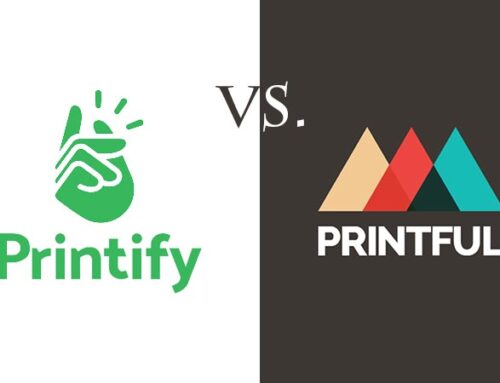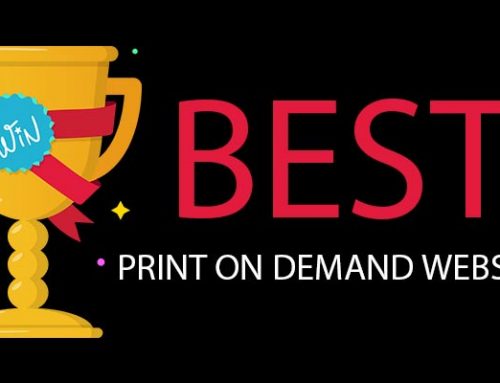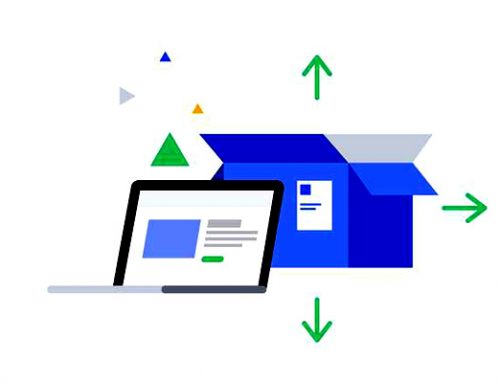Choosing between Shopify and Woocommerce for your on demand venture will chiefly rely on your needs. Generally, WooCommerce is the cheaper, flexible and SEO friendly for the tech savvy persons while shopify is an easy-to-use all-in-one package with a quality 24/7 support for the non-technical individuals.
As of today, these two web apps are the most popular e-commerce platforms available for anyone who would want to easily and quickly set up an affordable online Print on Demand shop.
Following is a discussion on which is suitable for who basing on the core features, differences, pros and cons of each of the platforms. In addition, find the available alternatives that can be used to build your POD business.
Shopify is a Better option …
Following are reasons to consider Shopify
- You’re a hands-off approach type of person and you don’t mind the cost this approach comes with. This means all you want is to launch a POD store and start selling your products straight away. You’ve no time to set up or handle any technical tasks.
- You lack web related skills and you do not intend to learn anytime soon. Or still you may have the technical skills but you’ve no time to invest in the whole process. All you are looking for is a straightforward all-in-one package that will let you upload your POD products immediately and make them(products) available to your customers!
- It is also the best option if you want a reliable and fast-responding support team at your disposal, who you can contact via phone, email or chat whenever you need help.
- It is also the perfect option if you’re want a scalable and robust system that will meet your future needs with no or limited downtime.
WooCommerce is a Better Option…
Choose WordPress’s WooCommerce plugin if the following goes inline with your needs.
- If you love being involved in every part of your store, this the best option. That is, if you want to be in full control of your Print on Demand store. Control in terms of how the system is technically created.
- It is the better option if you have minimal budget to start with, and you want to do everything yourself at your own pace and comfort. This means you’ll have time test while not spending a lot of money. It will help grow your store gradually while your are learning the tricks of the trade.
- You want a variety of both free and paid-for site designs (themes that will make your store look professional) and plugins that will enable you to extend the functionality of your store.
- If you have some web-related skills such as web server management, basic web design and CMS (Content Management System such as WordPress) know-how. Which implies that you would not mind spending a couple of hours setting things up, and you will handle the tasks required on your own. Optionally, it is still a good choice if you can afford to hire a skilled person to do it most probably on Fiverr or Upwork.
- It is also the best choice if you looking for a reliable and long-term option since you have control over most of your store data
Shopify Vs WooCommerce Pros & Cons
Shopify Strengths
Following are pros or benefits of using Shopify
1# All-in-one dedicated e-commerce Package
- Hosting included.
- Free subdomain is included for all plans(yourstorename.shopify.com)
- Free SSL certificate
- Unlimited Storage
- Ready-optimized for ecommerce
- Maintenance and backup
2 # Ease of use
You can launch your store in a few clicks. All you need is to sign up your store will be fully set up in a few minutes.
3 # Variety of payment options
Accept payments via PayPal, multiple payment gateways (including Stripe, credit cards), bank deposits, cash on delivery, and other methods estimated to be at least 70 options
4# Quality support 24/7
Reviews from a good number of Shopify users indicate that their customer support team is helpful, quick to respond and effective at resolving issues. You can get support via email, chat, and phone. In fact, this is Shopify’s distinctive selling point.
5# Multi-platform Integration
You can integrate with other POD marketplaces, social networks, major online stores and even WordPress. This provides a wider audience where can you sell your products.
6# Straightforward Management of Products and Collection
Shopify scores high in this department since it’s a dedicated e-commerce application. The developers have put a lot of work into this, and it is evident.
A unique time saving feature linked to this is Shopify’s ‘automated collections’ which allow you to use rules (based on things like product title, price, tag etc.) to create collections.
7# Dropshipping is thought to rather straightforward with Shopify.
Shopify Cons
Following are the weaknesses and disadvantages of using shopify to run your store
Shopify controls your store/website data
It is SAAS (Software As A Service) based proprietary platform meaning that you neither not own a copy nor control what happening behind the scenes
Need to know coding to customize extensively
You cannot fully customize you store to your liking. To make serious changes to your Shopify store, you will need to learn the company’s own coding language, Liquid. This requires at least some technical skill on your part.
Limited store designs and extensions (both free and paid for) available compared to WooCommerce
Limited SEO Options
SEO capabilities cannot be compared to WooCommerce which runs on WordPress
Monthly Fee
You have to pay the monthly subscription fee that most likely higher with time especially if you want to upgrade your plan or extend your store functionality
WooCommerce Pros
WooCommerce comes with following strengths
Free
WordPress and WooCommerce are Open Source which means free. There no monthly subscription fees. You can also own a copy of the app which you modify to all levels. However, this depends on the level of your technical skills.
Stable and Trusted
WordPress has a huge community online and runs the highest number of websites on the internet. It is one of the most popular web app. These qualities imply that that it is a stable and trusted platform to run your POD business.
Flexibility
If you could ask any experienced web programmer, they will tell you this web app is the most flexible. First, it an opensource app, second, it’s been developed with very popular web programming languages and third it has been around for people to understand and manipulate it.
Additionally, due its open-source nature, the number of themes, plugins and integrations for the platform surely surpass any other existing platform
Variety of Themes & Plugins.
There are thousands of themes and plugins both free and paid for. In fact, there are professional themes that are specifically for stores. The themes are mobile-friendly and some come with additional features that make customization a breeze.
Plugins also come in high numbers and there those that are created particularly for WooCommerce. This variety allows for limitless customization in terms of appearance and functionality
Control over your Product Data & Blog Content
Even though there are cases where a hosting company can take down self-hosted WooCommerce store, this rarely happens and even if it happens getting your content and product data either by exporting or importing should be an easy task. In a nutshell, whichever product you choose to upload to your WooCommerce store is up to you
Shopify on the hand can do away with your content and product data or in some cases your whole store can be taken down if you choose mess up with their acceptable use policies. Transfer of data isn’t as smooth as WooCommerce.
Multilingual and Multiple POD Stores
If you intend to create multiple versions of POD store that will serve different countries/languages, WooCommerce is the way to go. It is free! This is, to some extent, achievable in Shopify but you will need to pay a monthly for fully functional module.
Powerful SEO
Owing to the fact that WooCommerce runs on WordPress, a platform built with content management in mind, SEO (Search Engine Optimization) isn’t something that should worry you. WordPress allows you to install Yoast, one of the top SEO tools which allows you to manipulate product and blog post meta data
With a few tweaks, for instance, manipulating your product metadata, your can skyrocket rankings in no time.
Better Blogging Platform
Creating quality informative blog posts or articles related to your products is one of the strategies you can use to drive more traffic to your store which will eventually lead to more sales. WordPress, the core app on which WooCommerce runs on, is one of the most powerful blogging platforms.
It allows features like clean post urls, archiving categorizing of post. Shopify has blogging module but it’s not as developed as that of WordPress
WooCommerce Cons
Follow are reasons you may want to stay away from WordPress’s WooCommerce.
It is not an ecommerce-dedicated all-in-one package.
You will need the following services which in most cases are separate;
- Hosting Plan (file storage will depend on your plan)
- Domain name.
- SSL Certificate
- Though WooCommerce is free, it cannot run by itself. You need to have a running WordPress site
It is possible to find a specialized WordPress companies that offer all the above services as a single package but obviously at price that may not be that affordable.
Payment methods are limited compared to Shopify. Available methods include PayPal, Stripe, checks, bank transfers, cash on delivery.
Learning curve for Non-WordPress users
One of the biggest weakness of using WooCommerce for newbies is the very involving initial set up process which is composed of the following steps
- Acquire a domain name
- Buy a hosting plan
- Configure to ensure domain and hosting are connected and working
- Install WordPress and change the theme if you’re not comfortable with the default themes
- Install WooCommerce and other related plugins and thereafter work on little configurations.
If you’re already comfortable with WordPress, it is quite a simple process and your store should be up and running in few minutes.
However, as mentioned earlier, you can find specialized companies or simply hire an experienced WordPress developer. They are very many out there.
The other advantage is that once initial setup is done, costs of running your store will be very minimal.
Poor Quality Customer Support
Though it is true that WordPress has huge community online, getting instant support for instance via phone is not possible. You can either submit a ticket or search solutions to your issues on WooCommerce and WordPress forums.
It can be a quite time-consuming task for a newbie. However, as previously mentioned, this should not be a major complication if you’re already comfortable with WordPress or have hired an expert.
Plugins & Themes Quality
Due to the idea that this is an open source app, it means anyone, qualified or not qualified can create a theme or a plugin which will eventually ruin quality
Other alternative Web Apps create a POD Store
Wix
It is one of the cheapest out there. One outstanding feature of this platform is that it has a drag-and-drop editor which makes the best alternative for complete newbies with limited or no design skills.
Like Shopify you pay a monthly fee ($17 for the eCommerce plan)
BigCommerce
It is the best Shopify alternative. It works like Shopify but it comes with more inbuilt features.
Volusion
It is paid for platform like Shopify and and BigCommerce. One unique feature is its built-in dropshipping program.
Squarespace
It is basically a website builder to which an eCommerce functionality was added recently. It is thought to come with incredible themes but pricier than key players like Shopify
Open Source Shopify alternatives
Following are three top free web apps that are built to specifically work as an eCommerce store
- Pretashop
- OpenCart
- Magento
Drupal
Like WordPress, this is an open source Content Management System (CMS) with fully eCommerce functionality. It is built with security and speed in mind. However, you need more technical skills to use it effectively.
Joomla
It is also another open source CMS with eCommerce capabilities but as popular as WordPress or Drupal.
Ecwid
This is a standalone web app that can be integrated with any web site to add eCommerce functionality
Based on the above discussion on the the top on demand print web app comparison, it is clear that none totally better than the other. Both WooCommerce and Shopify come with strengths and weaknesses and at the end of the day it will depend on the user.
Once you’ve set up your store using any of the above POD web apps , you’d probably want to source your manufacturing and shipping services to a good fulfillment/dropshipping company. In this article, find how these companies work, what to look for when choosing and the reviews of the top.
What if this idea of creating a store sounds scary? Is there another option? Yes there is! Print on Demand Marketplaces. All you need is to create an account and start uploading your unique product designs.
Finally, you would want tips and hacks to make your store a success. Find out more in this piece: 11 clever ideas to skyrocket your print on demand profits




